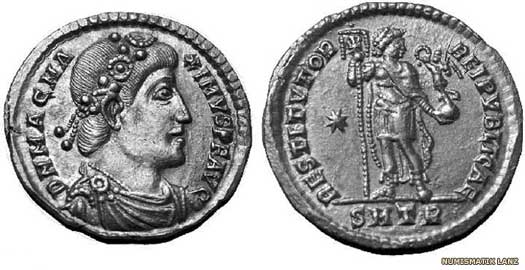| -Lutetia - Gallic Roman city. Eventually to become the city of Paris. |
Among other things I said: Element Two is the need to locate the characters and action in a place that adds to, that underpins, that shows rather than tells of the main themes of the novel. Think of the psychopathology of cities such as Dickens’ London and de Balzac’s Paris, of Martin Amis’s London and Ian Rankin’s Edinburgh. Think of the drawing rooms of Jane Austen, the muddy nightmarish battle trenches of Pat Barker, the Gothic moorland of the Brontes!
 |
| Deva (Chester) |
For me this is rather like saying that the British brought all that was is cultured and advanced the far reaches of its world empire...Or that the Germans brought efficiency and order to the muddled and inefficient European countries they conquered in WW2
 |
Coin issued by Magnus Maximus (Macsen Wledig) during his reign as co-emperor, holding a laburnum and Victory on a globe. |
One way I am approaching the issue in this novel is to use material objects and artefacts to supply the incidental close detail of place and time. These are embedded within the narrative like fine stitches in a piece of embroidery. My approach is to try to do this without telling or describing (not so easy!). Such objects and items, after all, are part of the taken for granted world of my characters. In the world of Elen, my main character, The threads that make up this embroidery would include naming of places and characters, the nature of the built world and the landscape, the spiritual beliefs of the communities and the skill sets of individuals.
If this subtle process works then I trust my reader will stay with me throughout the narrative in this similar-but- different land and in this different time, where human motives and preoccupations are identifiable with those that exist in our own modern world.
The other thing I've done for my reader is to include - in a section at the end of the novelI call Author's Extras - annotated lists including one of places in the ancient world. Another is about people. Another is about subsequent history and events. These are appendices as applied to fiction. The reader may use them if she or he chooses to further locate the story in place and time. For some this may not be necessary. For others it may add to their understanding and enjoyment of the novel.
Here is one Author's Extra - this one regarding elements of place for this novel:
Place names in Elen’s World
Note: Wales as an entity did not exist in Elen’s day. I have named her territory West Britain which reached as far north as York, as far west as Caernarvon and as far south as Caerleon.
Agatha: Port of Agde in South West France
Aquileia – an ancient Roman city in Italy, at the head of the Adriatic at the edge of the lagoons, about 10 km from the sea
Armorica – The name given in ancient times to the part of Gaul between the Seine and the Loire rivers, extending down the Atlantic Coast.
Luavalium - Carlisle Cumbria UK
Castra Deva – Chester UK
Deva Fluvius – River Dee UK
Eboracum – York UK
Hispania – The Roman name for the Iberian Peninsula
Isca – Caerleon in South East Wales UK
Lugdunum Lyon in France
Lutetia - Gallic Roman city. Eventually to become the city of Paris.
Lutetia - Gallic Roman city. Eventually to become the city of Paris.
Massalia – French city of Marseilles
Mediolanum – Milan Italy
Segontium Caernarfon, North Wales UK.
Trevorum – Trier - Ancient German city on the banks of the Moselle.
Vinovium – Roman Fort near Bishop Auckland in County Durham
 |
| Welsh landscape with pathway. |
No comments:
Post a Comment